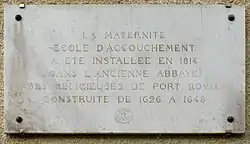Port-Royal Abbey, Paris
Port-Royal Abbey was an abbey in Paris that was a stronghold of Jansenism. The monastery of Port-Royal was founded in 1204 by Mathilde de Garland beside the River Rhodon and remained of minor importance until the end of the fifteenth century having declined in repute. From the early sixteenth century until its decimation in 1709 it was a highly influential religious establishment.

History
The local Arnauld family had great influence and Antoine Arnauld, secured by deceit, his daughter Jacqueline, the post of Abbess in 1602, when she was eleven years old. After seven years of anguish, Jacqueline underwent a revelation becoming very pious. She changed her name to become known as La Mère Angélique and set about radically improving the standards of the abbey. Despite attempts to have her and her loyal nuns expelled, La Mère Angélique retained her position until her retirement in 1630. The fame of both the moral La Mère Angélique and the Port-Royal Abbey spread far in France and gained favours with supporters of Jansenism. The abbey was expanded twice over the years due to the influx of novices and nuns. The original abbey became known as Port-Royal-des-Champs. In 1661, the powerful Cardinal Mazarin died and Louis XIV seized control of the government under the influence of his Jesuit confessor, Father Annat. In the same year La Mère Angélique died as did Pascal in 1662, losing the abbey strong patrons. Port-Royal suffered persecution until it was dissolved and the buildings torn down on orders of the king.[1]
Famous people who stayed at the Port-Royal Abbey include Marie de Rohan, intriguer during the Fronde; Jeanne Baptiste d'Albert de Luynes, future mistress of a duke of Savoy; Marie Angélique de Fontanges, mistress of Louis XIV, died here giving birth to his child who also died.
From 1793 remains of the abbey were used as a prison under the name Prison de Port-libre or Prison de la Bourbe. Chrétien Guillaume de Lamoignon de Malesherbes (lawyer for Louis XVI during his trial) and Madame de Tourzel, former governess of the "children of France", were held here.

Today its main cloister (illustration) forms part of the modern Hôpital Cochin.
Notable patrons

- Blaise Pascal[2]
- Jacqueline Pascal, sister of Blaise Pascal
- Madame du Valois[3]
- Marc-Antoine Charpentier
Footnotes
- Pages 119-137, Sainte Beuve by Harold Nicolson, published by Constable, London
- Page 134, Sainte-Beuve by Harold Nicolson
- Mary Anne Galton Schimmelpenninck, Select Memoirs of Port Royal.